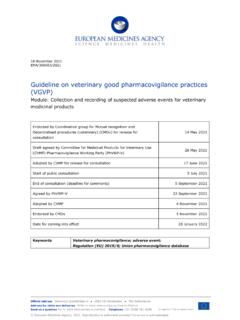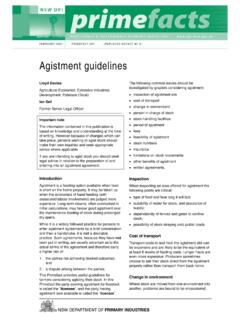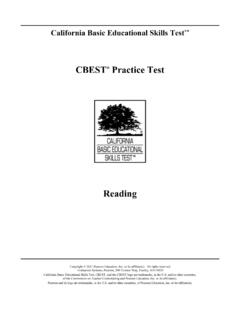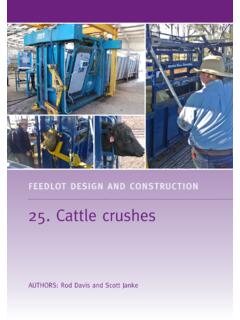Transcription of Secretary of State’s Standards of Modern Zoo Practice
1 Secretary of State s Standards of Modern Zoo Practice Secretary of State s Standards of Modern Zoo Practice Crown copyright 2012 You may re-use this information (not including logos) free of charge in any format or medium, under the terms of the Open Government Licence. To view this licence, visit or write to the Information Policy Team, The National Archives, Kew, London TW9 4DU, or e-mail: This document/publication is also available on our website at: Any enquiries regarding this document/publication should be sent to us at: Zoos Branch, Wildlife Species Conservation Department for Environment, Food and Rural Affairs Zone 1/14b Temple Quay House 2 The Square Temple Quay Bristol BS1 6EB Telephone: 0117 372 3606 Email: PB Number PB13806 Secretary of State s Standards of Modern Zoo Practice Contents Introduction.
2 1 Interpretation of terms used .. 1 animal welfare in the zoo environment .. 2 Section 1 - Provision of food and water .. 4 Section 2 - Provision of a suitable environment .. 6 Section 3 - Provision of animal health care .. 8 Routine observation .. 8 Enclosures .. 8 Veterinary care .. 8 Isolation and containment .. 10 Sanitation and control of disease .. 10 Specialist techniques .. 10 Section 4 - Provision of opportunity to express most normal behaviour .. 11 Section 5 - Provision of protection from fear and distress .. 12 Section 6 - Transportation and movement of live animals .. 13 Section 7 - Conservation and education measures .. 14 Conservation measures within and beyond the zoo .. 14 Education measures .. 14 Section 8 - Public safety in the zoo .. 16 Principles.
3 16 Insurance .. 16 Enclosures .. 16 Management and maintenance .. 17 Protection of public .. 17 Free-ranging species .. 18 Escapes .. 18 Exits .. 20 Signs .. 20 Section 9 - Stock records .. 21 Section 10 - Staff and training .. 23 Section 11 - Public facilities .. 24 First-Aid .. 24 Toilets .. 24 Parking .. 24 Provisions for particular needs .. 25 Section 12 - Display of zoo licence .. 26 Appendix 1- The EC Zoos Directive .. 27 Closure of zoos .. 27 Appendix 2 - Ethical review process .. 29 Appendix 3 - Conservation and education .. 31 Measures .. 31 Conservation .. 31 Education .. 32 Appendix 4 - animal transport, acquisition and disposal .. 33 Transport of live animals .. 33 animal acquisition .. 33 Disposal of live animals .. 33 Animals intended for release.
4 33 Euthanasia .. 34 Secretary of State s Standards of Modern Zoo Practice Appendix 5 - Veterinary facilities .. 35 Veterinary services .. 35 On-site facilities .. 36 Post-mortem facilities .. 36 Appendix 6 - animal contact areas .. 38 Introduction .. 38 General provisions .. 38 Walk-through exhibits .. 39 Diving experience exhibits .. 39 Touch-pools .. 40 Drive-through enclosures .. 40 Appendix 7 - Training of animals .. 42 General provision .. 42 Use of animals in demonstrations outside the zoo .. 42 Appendix 8 - Specialist exhibits .. 44 Invertebrates .. 44 Reptiles and amphibians .. 45 Venomous species .. 47 Pinnipeds and marine birds .. 47 Public 49 Waterfowl .. 51 Birds of prey .. 52 Elephants .. 55 Appendix 9 - Staff & staff training.
5 60 Training .. 60 Staff .. 60 Appendix 10 - Pre Inspection Audit Form .. 61 Appendix 11 - Inspection Report Form .. 61 Appendix 11A - Licence Inspection Form .. 61 Appendix 12 - Hazardous animal categorisation .. 62 Secretary of State s Standards of Modern Zoo Practice 1 Introduction 1. The EC Zoos Directive (Directive 1999/22/EC) requires EU Member States to regulate zoos in accordance with its provisions. The Directive is transposed into national legislation in England by means of the Zoo Licensing Act 1981 (Amendment) (England and Wales) Regulations 2002. Defra issued guidance on the provisions of the Zoo Licensing Act 1981 ( the Act ) in 20121. 2. References in these Standards , including to legislation, apply to England. Differences may apply in Wales and Scotland 3.
6 In pursuance of section 9 of the Act, the Secretary of State, having consulted such persons on a list compiled under Section 8 of the Act, and other persons as she has seen fit, hereby specifies the following Standards of Modern Zoo Practice (the Standards ); that is, Standards with respect to the management of zoos and the animals in them. Due to the widely differing nature of zoo collections, not every Standard will apply equally to all zoos. 4. To aid the application of these Standards , pre-inspection audit forms and inspection report forms are available at the following link Pre-inspection audit forms should be completed by zoo operators prior to inspections and inspection report forms should be used by zoo inspectors to report their findings. 5. Compliance with these Standards does not guarantee that the requirements of the Health and Safety at Work etc Act 1974 and other relevant legislation have been met.
7 In particular, attention is drawn to guidance issued by the Health and Safety Executive, relating to safety, health and welfare Standards for employers and persons at work in zoos. Zoo operators are strongly advised to acquaint themselves with these requirements and other relevant legislation including that on transport of animals, fire prevention and food hygiene. 6. These Standards are supplemented by the Zoos Expert Committee Handbook2 which provides further detail and guidance. The Handbook can be viewed on the following page of the Defra website: Interpretation of terms used 7. The following terms as defined here are used in these Standards and in associated documentation. animal means animals of the classes Mammalia, Aves, Reptilia, Amphibia, Pisces and Insecta ( any mammal, bird, reptile, amphibian, fish or insect) or other multicellular organism that is not a plant or fungus; animal training is the modification of an animal s behaviour by a human carer to achieve a goal; circus means a place where animals are kept or introduced wholly or mainly for the purpose of performing tricks or manoeuvres at that place; enclosure means any accommodation provided for zoo animals; 1 Zoo Licensing Act 1981: Guide to the Act s Provisions replaced Government Circular 02/2003 in 2012.
8 2 The Zoos Forum Handbook was replaced by the Zoos Expert Committee Handbook in 2012 Secretary of State s Standards of Modern Zoo Practice 2 enclosure barrier means a physical barrier to contain an animal within an enclosure; keeper includes any person employed under the direction of a keeper; the list means the list compiled by the Secretary of State under section 8 of the Zoo Licensing Act 1981. This list comprises persons responsible for the inspection of animals in zoos, and for advising on their keeping and welfare, and the management of zoos generally; pet shop means premises for whose keeping as a pet shop a licence is in force, or is required, under the Pet Animals Act 1951; stand-off barrier means a physical barrier set back from the outer edge of an enclosure barrier in order to provide further distance between the public and exhibited animals; taxonomic category means a group or assemblage of species recognised as an entity in scientific classification; wild animal means any animal not normally domesticated in Great Britain.
9 Zoo is defined under the Act as an establishment where wild animals (as defined above) are kept for exhibition to the public otherwise than for purposes of a circus ( circus means a place where animals are kept or introduced wholly or mainly for the purpose of performing tricks or manoeuvres at that place) and otherwise than in a pet shop (as defined above). The Act applies to any zoo to which members of the public have access, with or without charge for admission, on seven days or more in any period of 12 consecutive months. Under the EC Zoos Directive, zoos may be exempted from the requirements of the Directive on the grounds that they do not exhibit a significant number of animals or species to the public and that the exemption will not jeopardise the objectives of the Directive.
10 animal welfare in the zoo environment 8. The five principles below, described in more detail in subsequent sections, provide a framework for the Standards . These five principles are based on the Five Freedoms drawn up for livestock by the Farm animal Welfare Committee. Provision of food and water 9. Both food and water are basic needs. The method of food presentation, the frequency of feeds and the nutritional balance must be taken into account. Food should be presented in a manner and frequency commensurate with the natural behaviour of the species, as well as its nutritional requirements, which may vary according to season. Provision of a suitable environment 10. An environment consistent with species requirements must be provided. This should include shade and shelter from rain, heat and cold as appropriate.













